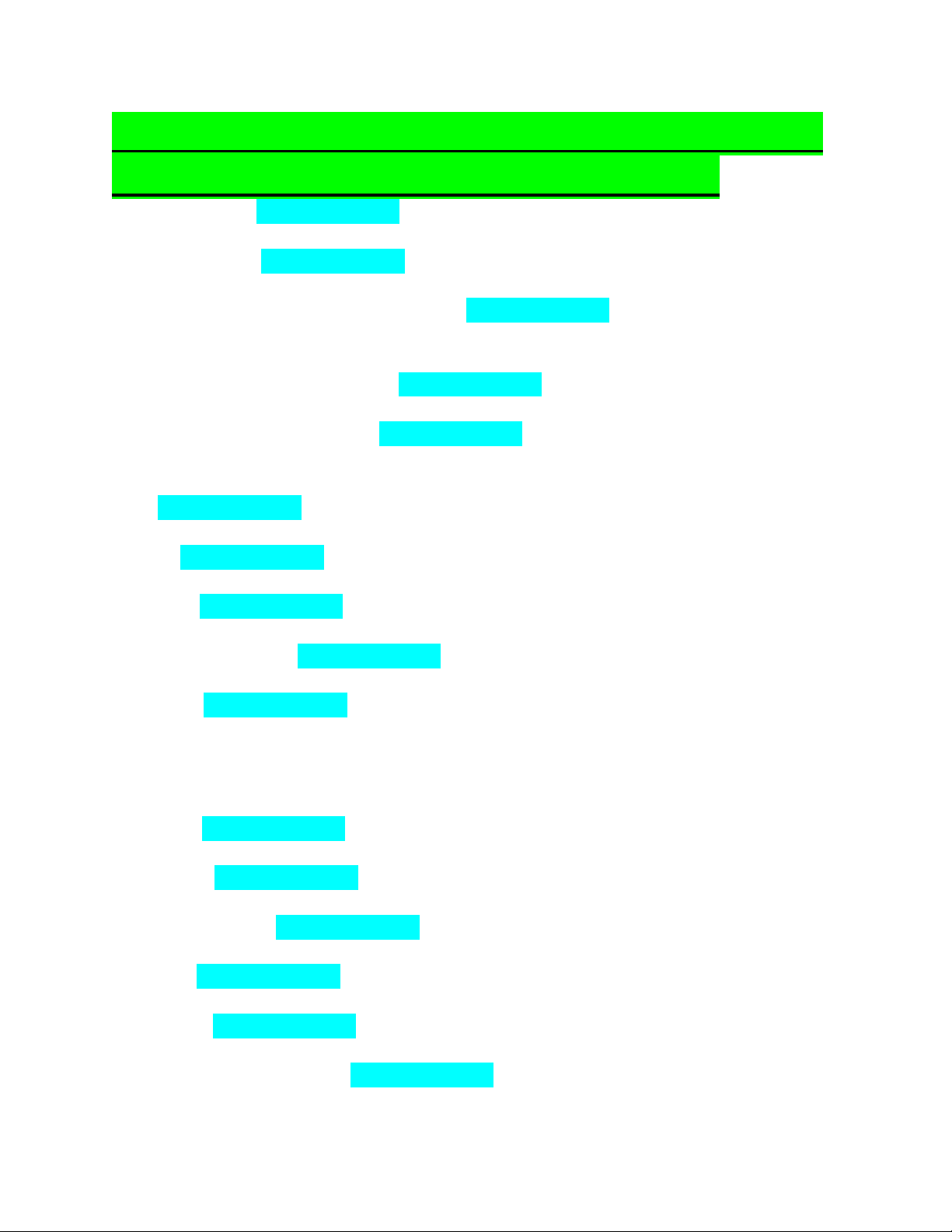


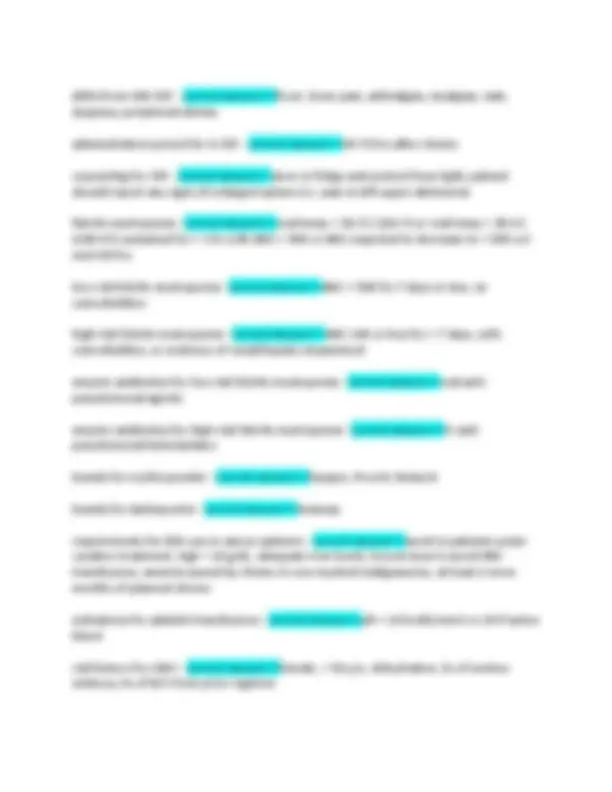
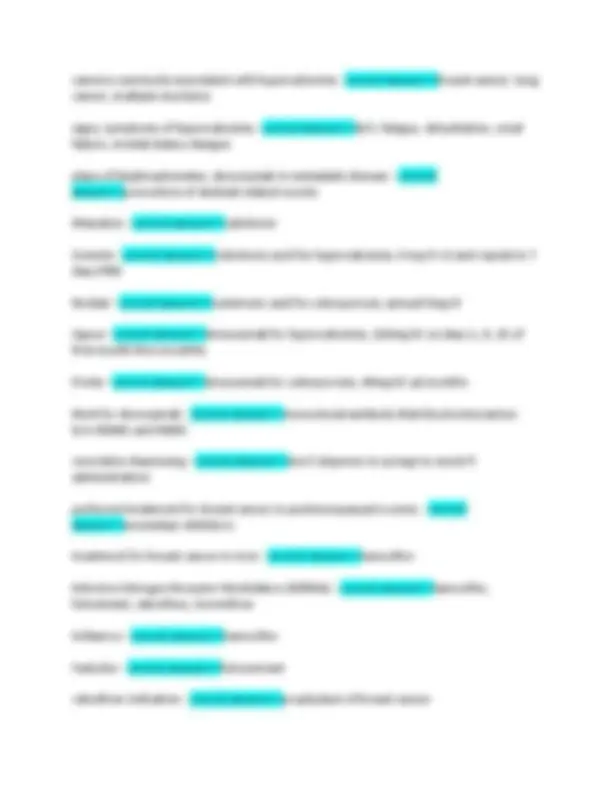

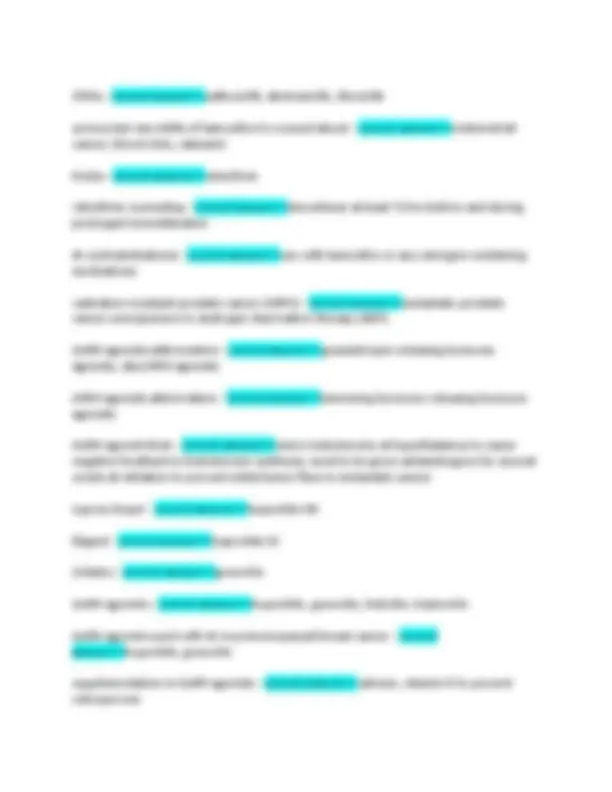
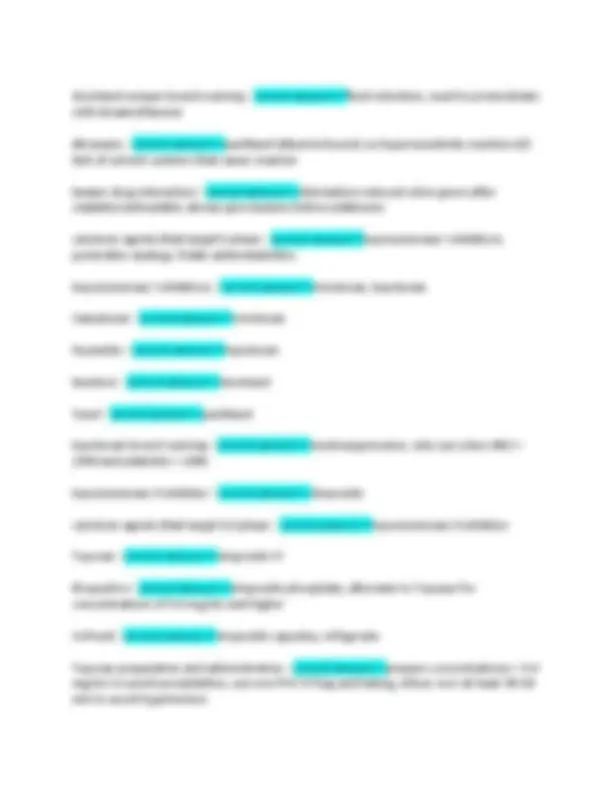
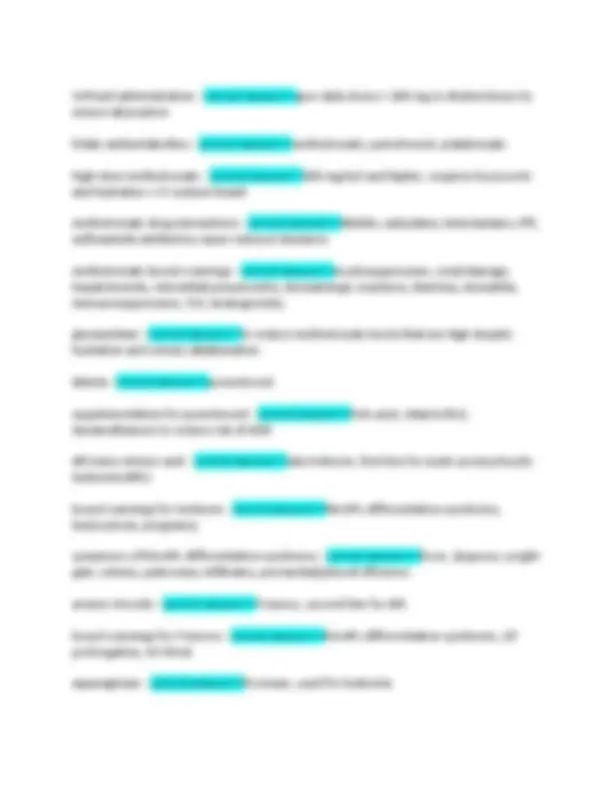
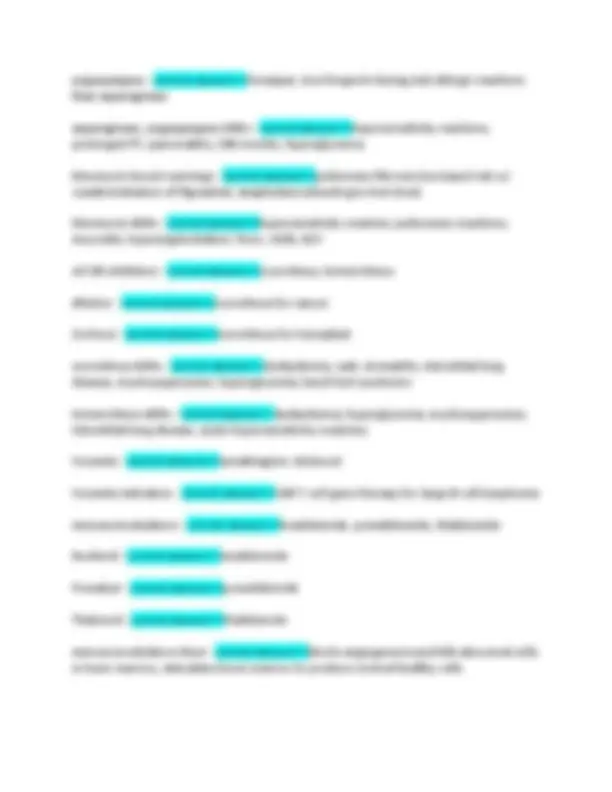




Study with the several resources on Docsity

Earn points by helping other students or get them with a premium plan


Prepare for your exams
Study with the several resources on Docsity

Earn points to download
Earn points by helping other students or get them with a premium plan
Community
Ask the community for help and clear up your study doubts
Discover the best universities in your country according to Docsity users
Free resources
Download our free guides on studying techniques, anxiety management strategies, and thesis advice from Docsity tutors
Major vesicants - correct answer>>anthracyclines, vinca alkaloids Warm compress - correct answer>>vinca alkaloids, etoposide Antidotes for anthracycline extravasation - correct answer>>dexrazoxane or dimethyl sulfoxide Antidotes for vinca extravasation - correct answer>>hyaluronidase agents ok for IT administration - correct answer>>cytarabine, methotrexate, hydrocortisone, thiotepa ESA - correct answer>>erythropoietin, darbepoetin Granix - correct answer>>TBO-filgrastim Neulasta - correct answer>>Pegfilgrastim filgrastim biosimilars - correct answer>>Zarxio, Neupogen CAUTION - correct answer>>Change in bowel/bladder habits, A sore that doesn't heal, Unusual bleeding/discharge, Thickening/lump in breast or elsewhere, Indigestion/difficulty swallowing, Obvious change in wart or mole, Nagging cough or
Typology: Exams
1 / 19

This page cannot be seen from the preview
Don't miss anything!












Major vesicants - correct answer>>anthracyclines, vinca alkaloids Warm compress - correct answer>>vinca alkaloids, etoposide Antidotes for anthracycline extravasation - correct answer>>dexrazoxane or dimethyl sulfoxide Antidotes for vinca extravasation - correct answer>>hyaluronidase agents ok for IT administration - correct answer>>cytarabine, methotrexate, hydrocortisone, thiotepa ESA - correct answer>>erythropoietin, darbepoetin Granix - correct answer>>TBO-filgrastim Neulasta - correct answer>>Pegfilgrastim filgrastim biosimilars - correct answer>>Zarxio, Neupogen CAUTION - correct answer>>Change in bowel/bladder habits, A sore that doesn't heal, Unusual bleeding/discharge, Thickening/lump in breast or elsewhere, Indigestion/difficulty swallowing, Obvious change in wart or mole, Nagging cough or hoarseness leukemia - correct answer>>cancer of WBCs lymphoma - correct answer>>cancer of lymphatic system multiple myeloma - correct answer>>bone marrow cancer sarcoma - correct answer>>cancer of connective tissue carcinoma - correct answer>>cancer starting in skin or tissue lining internal organs screening for breast cancer - correct answer>>yearly mammograms starting at 45 y/o, may screen q2 years at 55 y/o and older
screening for cervical cancer - correct answer>>pap smear q3 years starting at 21 y/o, pap smear + HPV test q5 years at 30 y/o screening for colon cancer - correct answer>>start at 45 y/o, both stool-based tests and visual exams stool-based tests for colon cancer screening - correct answer>>yearly fecal occult blood test (FOBT) or stool DNA test q3 years visual exams for colon cancer screening - correct answer>>colonoscopy q10 years or flexible sigmoidoscopy (FSIG) q5 years requirements for annual CT scan for lung cancer screening - correct answer>>in good health, have at least a 30 pack-year smoking history, still smoking or quit smoking w/i past 15 years max lifetime cumulative dose for bleomycin - correct answer>>400 units d/t pulmonary toxicity max lifetime cumulative dose for doxorubicin - correct answer>> 450 - 550 mg/m2 d/t cardiotoxicity max dose per cycle for cisplatin - correct answer>>100 mg/m2 d/t nephrotoxicity max single dose for vincristine - correct answer>>2 mg per week recommended d/t neuropathy chemo agents that don't cause myelosuppression - correct answer>>asparaginase, bleomycin, vincristine and most TKIs chemo agents that cause N/V - correct answer>>cisplatin, cyclophosphamide, ifosfamide chemo agents that cause mucositis - correct answer>>fluorouracil, capecitabine, irinotecan, methotrexate, TKIs (-nibs) chemo agents that cause diarrhea - correct answer>>fluorouracil, capecitabine, irinotecan, TKIs (sorafenib, sunitinib)
dexrazoxane used as prophylaxis - correct answer>>Zinecard for cardiomyopathy d/t doxorubicin; consider for doxorubicin cumulative dose > 300 mg/m dexrazoxane used as treatment - correct answer>>Totect for extravasation d/t doxorubicin cofactor for fluorouracil - correct answer>>leucovorin or Fusilev Vistogard - correct answer>>uridine triacetate; antidote for fluorouracil or capecitabine to be used w/i 96 hours antidotes for methotrexate - correct answer>>leucovorin, glucarpidase Voraxaze - correct answer>>glucarpidase nadir for WBC and platelets - correct answer>> 7 - 14 days post chemotherapy recovery period for WBC and platelets - correct answer>> 3 - 4 weeks post chemotherapy ANC for neutropenia - correct answer>>< 1000 cells/mm ANC for severe neutropenia - correct answer>>< 500 cells/mm ANC for profound neutropenia - correct answer>>< 100 cells/mm CSF indicated for prevention of febrile neutropenia - correct answer>>G-CSF (filgrastim) and pegylated G-CSF (pegfilgrastim) CSF indicated for stem cell transplantation - correct answer>>GM-CSF (sargramostim) role of CSF in cancer patients - correct answer>>prophylaxis reduce mortality from from infections in patients at high risk of febrile neutropenia dosing for filgrastim - correct answer>>weight-based dose given daily via IV/SC dosing for pegfilgrastim - correct answer>>6 mg SC once per chemo cycle, at least 14 days before next cycle ADRs from G-CSFs - correct answer>>bone pain, fever, glomerulonephritis
ADRs from GM-CSF - correct answer>>fever, bone pain, arthralgias, myalgias, rash, dyspnea, peripheral edema administration period for G-CSF - correct answer>> 24 - 72 hrs after chemo counseling for CSF - correct answer>>store in fridge and protect from light; patient should report any signs of enlarged spleen (i.e. pain in left upper abdomen) febrile neutropenia - correct answer>>oral temp > 38.3 C (101 F) or oral temp > 38.0 C (100.4 F) sustained for > 1 hr with ANC < 500 or ANC expected to decrease to < 500 w/i next 48 hrs low-risk febrile neutropenia - correct answer>>ANC < 500 for 7 days or less, no comorbidities high-risk febrile neutropenia - correct answer>>ANC 100 or less for > 7 days, with comorbidities, or evidence of renal/hepatic impairment empiric antibiotics for low-risk febrile neutropenia - correct answer>>oral anti- pseudomonal agents empiric antibiotics for high-risk febrile neutropenia - correct answer>>IV anti- pseudomonal beta-lactams brands for erythropoietin - correct answer>>Epogen, Procrit, Retacrit brands for darbepoetin - correct answer>>Aranesp requirements for ESA use in cancer patients - correct answer>>avoid in patients under curative treatment, Hgb < 10 g/dL, adequate iron levels, lowest dose to avoid RBC transfusions, anemia caused by chemo in non-myeloid malignancies, at least 2 more months of planned chemo indications for platelet transfusions - correct answer>>plt < 10 kcells/mm3 or 20 if active bleed risk factors for CINV - correct answer>>female, < 50 y/o, dehydration, hx of motion sickness, hx of N/V from prior regimen
Anzemet - correct answer>>dolasetron (only PO used for CINV d/t QT prolongation w/ IV) Aloxi - correct answer>>palonosetron IV CI for 5HT3 RA - correct answer>>avoid use w/ apomorphine (Apokyn) d/t severe hypotension and loss of consciousness Sustol - correct answer>>granisetron SC MoA for DA antagonist for CINV - correct answer>>block DA receptors in chemoreceptor trigger zone of CNS Cesamet - correct answer>>nabilone, C-II Marinol - correct answer>>dronabinol, C-III boxed warning for promethazine - correct answer>>don't use in children < 2 y/o, don't administer via intra-arterial or SC administration, risk of extravasation w/ IV use boxed warning for metoclopramide - correct answer>>possibly irreversible TD boxed warning for droperidol - correct answer>>QT prolongation and serious arrhythmia antimotility agents for CID - correct answer>>loperamide, diphenoxylate + atropine max doses of loperamide - correct answer>>16 mg/day normally, 24 mg/day for CID delayed CID - correct answer>>fluorouracil, capecitabine, irinotecan symptoms of early onset diarrhea from irinotecan - correct answer>>diarrhea, cramping, rhinitis, lacrimation, salivation palmar-plantar erythrodysesthesia - correct answer>>hand-foot syndrome chemo agents that cause hand-foot syndrome - correct answer>>fluorouracil, capecitabine, cytarabine, liposomal doxorubicin
cancers commonly associated with hypercalcemia - correct answer>>breast cancer, lung cancer, multiple myeloma signs, symptoms of hypercalcemia - correct answer>>N/V, fatigue, dehydration, renal failure, mental status changes place of bisphosphonates, denosumab in metastatic disease - correct answer>>prevention of skeletal related events Miacalcin - correct answer>>calcitonin Zometa - correct answer>>zoledronic acid for hypercalcemia, 4 mg IV x1 and repeat in 7 days PRN Reclast - correct answer>>zoledronic acid for osteoporosis, annual 5mg IV Xgeva - correct answer>>denosumab for hypercalcemia, 120mg SC on days 1, 8, 15 of first month then monthly Prolia - correct answer>>denosumab for osteoporosis, 60mg SC q6 months MoA for denosumab - correct answer>>monoclonal antibody that blocks interaction b/w RANKL and RANK vincristine dispensing - correct answer>>don't dispense in syringe to avoid IT administration preferred treatment for breast cancer in postmenopausal women - correct answer>>aromatase inhibitors treatment for breast cancer in men - correct answer>>tamoxifen Selective Estrogen Receptor Modulators (SERMs) - correct answer>>tamoxifen, fulvestrant, raloxifene, toremifene Soltamox - correct answer>>tamoxifen Faslodex - correct answer>>fulvesetrant raloxifene indication - correct answer>>prophylaxis of breast cancer
CDKIs - correct answer>>palbociclib, abemaciclib, ribociclib serious but rare ADRs of tamoxifen to counsel about - correct answer>>endometrial cancer, blood clots, cataracts Evista - correct answer>>raloxifene raloxifene counseling - correct answer>>discontinue at least 72 hrs before and during prolonged immobilization AI contraindications - correct answer>>use with tamoxifen or any estrogen-containing medications castration-resistant prostate cancer (CRPC) - correct answer>>metastatic prostate cancer unresponsive to androgen deprivation therapy (ADT) GnRH agonists abbreviation - correct answer>>gonadotropin releasing hormone agonists, aka LHRH agonists LHRH agonists abbreviation - correct answer>>luteinizing hormone releasing hormone agonsits GnRH agonist MoA - correct answer>>mimic testosterone at hypothalamus to cause negative feedback in testosterone synthesis; need to be given antiandrogens for several weeks at initiation to prevent initial tumor flare in metastatic cancer Lupron Depot - correct answer>>leuprolide IM Eligard - correct answer>>leuprolide SC Zoladex - correct answer>>goserelin GnRH agonists - correct answer>>leuprolide, goserelin, histrelin, triptorelin GnRH agonists used with AI in premenopausal breast cancer - correct answer>>leuprolide, goserelin supplementation in GnRH agonists - correct answer>>calcium, vitamin D to prevent osteoporosis
GnRH agonists ADRs - correct answer>>hot flashes, impotence, gynecomastia, peripheral edema, bone pain, injection site pain, QT prolongation, dyslipidemia, hyperglycemia GnRH antagonist - correct answer>>degarelix Firmagon - correct answer>>degarelix degarelix ADRs - correct answer>>same as GnRH agonists + hypersensitivity reactions 1st generation antiandrogens - correct answer>>bicalutamide, flutamide, nilutamide Casodex - correct answer>>bicalutamide indication for 1st gen antiandrogens - correct answer>>in combo with GnRH agonists to prevent tumor flare 2nd gen antiandrogen - correct answer>>enzalutamide Xtandi - correct answer>>enzalutamide androgen biosynthesis inhibitor MoA - correct answer>>interferes with CYP-17 enzymes involved in biosynthesis of steroid hormones to decrease testosterone production androgen biosynthesis inhibitor - correct answer>>abiraterone; needs to be given with prednisone to prevent hyperaldosteronism commonly used BSA formulas - correct answer>>DuBois and DuBois, Mostellar cell cycle non-specific cytotoxic agents - correct answer>>alkylating agents, platinums, anthracyclines, cell cycle specific cytotoxic agents - correct answer>>vinca alkaloids, taxanes, topoisomerase inhibitors, pyrimidine analogs, folate antimetabolites, alkylating agents - correct answer>>cyclophosphamide, ifosfamide, carmustine, bendamustine, busulfan, melphalan, dacarbazine, procarbazine, altretamine, lomustine, mechlorethamine, temozolomide
docetaxel unique boxed warning - correct answer>>fluid retention, need to premedicate with dexamethasone Abraxane - correct answer>>paclitaxel albumin-bound; no hypersensitivity reaction d/t lack of solvent systems that cause reaction taxane drug interaction - correct answer>>elimination reduced when given after cisplatin/carboplatin; always give taxanes before platinums cytotoxic agents that target S phase - correct answer>>topoisomerase I inhibitors, pyrimidine analogs, folate antimetabolites topoisomerase I inhibitors - correct answer>>irinotecan, topotecan Camptosar - correct answer>>irinotecan Hycamtin - correct answer>>topotecan taxotere - correct answer>>docetaxel Taxol - correct answer>>paclitaxel topotecan boxed warning - correct answer>>myelosuppression, only use when ANC > 1500 and platelets > 100k topoisomerase II inhibitor - correct answer>>etoposide cytotoxic agents that target G2 phase - correct answer>>topoisomerase II inhibitor Toposar - correct answer>>etoposide IV Etopophos - correct answer>>etoposide phosphate; alternate to Toposar for concentrations of 0.4 mg/mL and higher VePesid - correct answer>>etoposide capsules; refrigerate Toposar preparation and administration - correct answer>>prepare concentrations < 0. mg/mL to avoid precipitation, use non-PVC IV bag and tubing, infuse over at least 30- 60 min to avoid hypotension
VePesid administration - correct answer>>give daily doses > 200 mg in divided doses to ensure absorption folate antimetabolites - correct answer>>methotrexate, pemetrexed, pralatrexate high-dose methotrexate - correct answer>>500 mg/m2 and higher, requires leucovorin and hydration + IV sodium bicarb methotrexate drug interactions - correct answer>>NSAIDs, salicylates, beta-lactams, PPI, sulfonamide antibiotics cause reduced clearance methotrexate boxed warnings - correct answer>>myelosuppression, renal damage, hepatotoxicity, interstitial pneumonitis, dermatologic reactions, diarrhea, stomatitis, immunosuppression, TLS, teratogenicity glucarpidase - correct answer>>to reduce methotrexate levels that are high despite hydration and urinary alkalinization Alimta - correct answer>>pemetrexed supplementation for pemetrexed - correct answer>>folic acid, vitamin B12, dexamethasone to reduce risk of ADR All-trans retinoic acid - correct answer>>aka tretinoin, first-line for acute promyelocytic leukemia (APL) boxed warnings for tretinoin - correct answer>>RA-APL differentiation syndrome, leukocytosis, pregnancy symptoms of RA-APL differentiation syndrome - correct answer>>fever, dyspnea, weight gain, edema, pulmonary infiltrates, pericardial/pleural effusions arsenic trioxide - correct answer>>Trisenox, second-line for APL boxed warnings for Trisenox - correct answer>>RA-APL differentiation syndrome, QT prolongation, AV block asparaginase - correct answer>>Erwinaze, used for leukemia
immunomodulators boxed warnings - correct answer>>fetal risk/pregnancy (REMS), thrombosis, hematologic toxicity (lenalidomide) proteasome inhibitors - correct answer>>bortezomib, carfilzomib bortezomib ADR - correct answer>>peripheral neuropathy, psychiatric disturbances, cardiotoxicity, pulmonary toxicity, neutropenia (antiviral for preventing herpes reactivation) carfilzomib ADRs - correct answer>>peripheral neuropathy, fatigue, pulmonary toxicity, hepatotoxicity VEGF inhibitors - correct answer>>bevacizumab, ramucirumab VEGF inhibitors MoA - correct answer>>inhibits growth of blood vessels VEGF inhibitors ADRs - correct answer>>HTN, proteinuria, nephrotic syndrome, heart failure, thrombosis, impaired wound healing (don't administer for 28 days before and after surgery) VEGF inhibitor boxed warnings - correct answer>>severe/fatal bleeding, GI perforation, surgical wound dehiscence HER2 inhibitors - correct answer>>trastuzumab, pertuzumab, Ado-trastuzumab emtansine Avastin - correct answer>>bevacizumab Cyramza - correct answer>>ramucirumab Herceptin - correct answer>>trastuzumab Kadcyla - correct answer>>Ado-trastuzumab emtansine HER2 inhibitors boxed warnings - correct answer>>heart failure (LVEF monitoring with ECG or MUGA scan), embryo-fetal death monocolonal EGFR inhibitors - correct answer>>cetuximab, panitumumab Erbitux - correct answer>>cetuximab
Vectibix - correct answer>>panitumumab monoclonal EGFR inhibitor administration - correct answer>>must be KRAS wild type, better efficacy with EGFR positive expression, premedicate first dose with Benadryl and use 0.22 micron filter EGFR inhibitor ADRs - correct answer>>acneiform rash (indicates better response), skin toxicities, ocular toxicities management of monoclonal EGFR inhibitor rash - correct answer>>avoid sunlight and use sunscreen, topical steroids, antibiotics for prophylaxis or treatment CD 20 antigen inhibitors - correct answer>>rituximab, ofatumumab, obinutuzumab Rituxan - correct answer>>rituximab CD 20 antigen inhibitors administration - correct answer>>must be CD20 positive; premedicate with Benadryl, APAP, steroid rituximab boxed warnings - correct answer>>hep B reactivation, progressive multifocal leukoencephalopathy, serious skin reactions, infusion-related reactions Blincyto - correct answer>>blinatumomab blinatumomab pharmacogenomics - correct answer>>must be positive for CD19 and 30 antigens PD-1 inhibitors - correct answer>>pembrolizumab, nivolumab, atezolizumab Keytruda - correct answer>>pembrolizumab Opdivo - correct answer>>nivolumab CTLA-4 Inhibitor - correct answer>>ipilimumab (Yervoy) CTLA-4 abbreviation - correct answer>>cytotoxic T-lymphocyte antigen- 4 Yervoy boxed warning - correct answer>>fatal immune-mediated reactions (requires REMS)
oral agents to be taken on an empty stomach - correct answer>>nilotinib, erlotinib, soratenib, temozolomide, abiraterone, pomalidomide teratogenic oral agents - correct answer>>thalidomide, pomalidomide, lenalidomide require 2 negative pregnancy tests and 2 forms of birth control agents requiring non-PVC bag/tubing - correct answer>>taxanes, etoposide (Toposar), temsirolimus